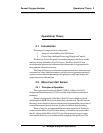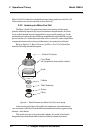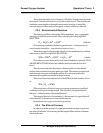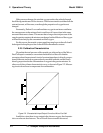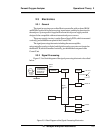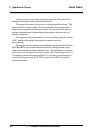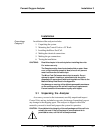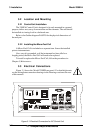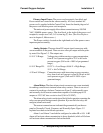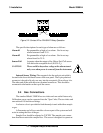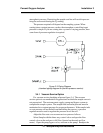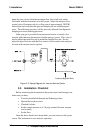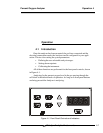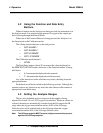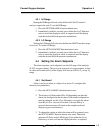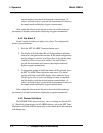
3-3
Percent Oxygen Analyzer Installation 3
Teledyne Analytical Instruments
Primary Input Power: The power cord receptacle, fuse block and
Power switch are located in the same assembly. A 6-foot, standard AC
power cord is supplied with the Control Unit. Insert the female plug end of
the power cord into the power cord receptacle.
The universal power supply allows direct connection to any 100-240
VAC, 50/60Hz power source. The fuse block, to the right of the power cord
receptacle, accepts two 3AG, 0.5 A, time-lag (T) fuse. (See Fuse Replace-
ment in chapter 5, Maintenance.)
The Power switch is located on the right-hand end of the power source
input receptacle assembly.
Analog Outputs: There are three DC output signal connectors with
screw terminals on the panel. There are two wires per output with the polar-
ity noted. See Figure 3-3. The outputs are:
0–10 V % Range: Voltage rises with increasing oxygen concentration,
from 0 V at 0 percent oxygen to 10 V at full scale
percent oxygen. (Full scale = 100% of programmed
range.)
0–10 V Range ID: 03.33 V = Low Range, 06.66 V = High Range,
10 V = Air Cal Range.
4–20 mA % Range: Current increases with increasing oxygen concentra-
tion, from 4 mA at 0 percent oxygen to 20 mA at full
scale percent oxygen. (Full scale = 100% of pro-
grammed range.)
Alarm Relays: The three alarm-circuit connectors are screw terminals
for making connections to internal alarm relay contacts. There is one set of
contacts for each type of alarm. Contacts are Form C, with normally open
and normally closed contact connections capable of switching up to 0.5
ampere at 125 VAC into a resistive load (2A for 30 VDC).
The alarm relay circuits are designed for failsafe operation, meaning the
relays are energized during normal operation. If power fails the relays de-
energize (alarms activated).
The contact connections are indicated diagrammatically on the rear
panel as Normally Closed, Common, and Normally Open. Figure 3-2
explains how these act in failsafe operation.
Alarm 1 and Alarm 2 can both be configured as either HI or LO. A HI
alarm will activate when concentration is above threshold, while a LO alarm
will activate when concentration is below threshold.



